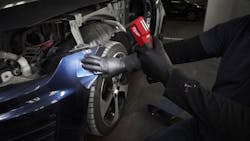Should you use a color match light?
Related To:
Oct. 6, 2022
4 min read
A color match light is used by automotive painters and detailers to mimic sunlight with a high color rendering index (CRI) and multiple color temperatures. CRI is the measurement of light in relation to how it affects the appearance of color. For example, the sun has the highest CRI of 100 and reflects colors in a vehicle’s paint differently during morning, mid-day, and overcast times. Color match lights have high CRI’s and different color temperatures to aid professionals in detecting variance in paint color when matching. Automotive painters use the light to ensure that when a car gets into a crash, the dented part is replaced with the same paint color as the rest of the vehicle. Similarly, a high CRI aids automotive detailers to see swirl marks and scratches in the paint, as well as perform spot paint corrections.
Why use a color match light?
When manufacturers produce a vehicle, a paint code is tied to that vehicle. Each paint code can have a multitude of variants, depending on the color. Variants are different formulas of mixed paint that all appear to be the same color, but when you shine a high CRI color match light on these variants, sometimes called paint chips, you can detect the difference in color.
For automotive body painters, color matching is the process of checking a vehicle’s paint against the manufacturer paint chips to understand the differences in color and metallics. Multiple color temperatures reflect the full spectrum of sunlight and allow users to pull out variations of color as well as confirm color accuracy under the same sunlight as the day the customer comes to pick up their vehicle, giving the painter more confidence in their match. Additionally, high output allows painters to check if enough layers of paint have been applied to seamlessly match the rest of the vehicle.
Likewise, automotive detailers can best use a color match light for identifying paint damage. Detailers can use specific color temperatures on certain colored vehicles to pull out imperfections in the paint. For example, red cars typically need a warmer color temperature to see imperfections that need correction. Color match lights can provide a full spectrum of sunlight so professionals can adapt to each vehicle as needed. Furthermore, the light is ideal for detailers when checking the vehicle paint for scratches or swirl marks while buffing, and again when removing imperfections during finishing.
Pointers for color matching
When it comes to automotive body painting, a color match light is crucial for producing a consistent color, both on the damaged part and the entirety of the vehicle. The color matching process helps avoid mistakes and re-works that could be very costly and time consuming for the painter and customer. Prior to painting, the painter will perform a color match application by comparing manufacturer paint chips to the vehicle’s body. When paired with a proper color matching light, professionals can spot the difference in colors and metallics to better match the paint tones. After painting, the technician should turn the booth lights off and check the paint coverage with a color matching light to ensure it has been evenly applied and the number of coats matches the rest of the vehicle.
Automotive detailers can best utilize a color match light for identifying scratches on the paint’s surface that require correction. As the detailer starts buffing, they should periodically check their work to ensure all scratches are taken out of the paint. Once all the scratches have been identified and removed, detailers can continue to begin polishing applications. Deeper scratches formed by pebbles or other debris may require spot paint correction, which is a can be more extensive form of buffing and polishing. After completing these tasks, detailers should wipe the surface clean and check their work again with a color match light to spot errors. This process helps technicians avoids time consuming corrections down the road and helps ensure they are producing the highest quality of work.
As automotive body painters and detailers perform color matching, they should be looking for lighting solutions that can provide the performance, functionality, and durability required for a successful application. For example, the Milwaukee M12 Paint and Detailing Color Match Light delivers a 98+ CRI rating and 1000 lumens with five color temperatures to provide a full spectrum of sunlight and is durably designed to withstand automotive shop conditions.
About the Author

Jason Isaacs
Jason Isaacs is the director of product marketing at Milwaukee Tool. He joined the company in 2013 as a part of its lighting team. He is now directly responsible for overseeing product strategy and development for the company’s lighting business unit. Prior to joining Milwaukee Tool, Isaacs worked as a field marketing and sales representative for Techtronic Industries, after receiving his Bachelors of Business Administration from University of Nebraska.
Sign up for FenderBender and ABRN Newsletters
Get the latest news and updates.
